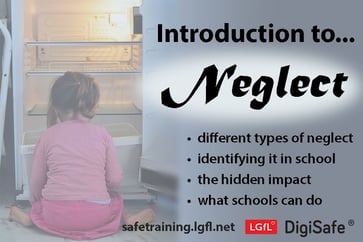Safeguarding Blog
Neglect and Poverty: Successfully identifying and recording concerns
Alex Dave, our new DigiSafe colleague, explores the link between neglect and poverty and asks DSLs to consider how they successfully identify and record concerns of neglect. Please also sign up for our new Introduction to Neglect training.
 Poverty - the current context
Poverty - the current context
The cost-of-living crisis is hitting many families like a sledgehammer. According to the latest statistics from the Joseph Rowntree Foundation, child poverty continues to rise with almost one in three children in the UK living in poverty (31%) - and the Resolution Foundation predicts that 500,000 more children will fall into absolute poverty in 2023. Poverty is leading to painful decisions that no parent wants to make; the choice between whether a child has a meal, whether the house is warm or whether they buy essentials like basic sanitary products.
Therefore, it is clear to see that this ongoing crisis is going to have a knock-on effect on the prevalence of neglect in our society, and we are sure that you are probably already seeing the impact of this in your school. Schools not only see neglected children and their associated physical/emotional/behavioural presentation, but also experience the effect of neglect through children's impacted learning and outcomes.
Definition of Neglect
As a reminder, neglect is defined in Working Together to Safeguard Children as the following:
|
“the persistent failure to meet a child’s basic physical and/or psychological needs, likely to result in the serious impairment of the child’s health or development. Neglect may occur during pregnancy as a result of maternal substance abuse. Once a child is born, neglect may involve a parent or carer failing to:
|
Making the link - Neglect and Poverty
Although poverty doesn’t directly lead to neglectful care (and most children who live in poverty are not neglected) there is an inextricable link. If parents don’t have the economic resource to provide for their child’s basic needs (such as food, clothing and shelter) then it’s understandable that their children may experience neglect. But poverty also has an indirect link to neglect, whereby parents living in poverty are more likely to experience mental health issues, domestic abuse, substance misuse, family breakdown and social isolation - all of which can then impact parenting. So, unlike most other types of maltreatment, neglect is usually unintentional and occurs as a by-product of various and sometimes multiple risk factors and/or stressors within the family. Therefore, how we respond to this and ultimately protect children from (further) harm, will need to be different to other forms of abuse.
Not only is it usually unintentional, but neglectful care often fluctuates - meaning the quality of care that a child receives may be fine at times, but at other times (of the week or the month, perhaps related to income), it is not. As schools, how do we help such families, and at what point do the concerns become 'persistent' and therefore require further intervention?
Reflection Points
How do the above considerations influence and impact our identification and decision-making about neglect?
- Do you consider poverty and a family’s lived experience of it when trying to engage and work with them? We need to take time to understand the families that we work with, including acknowledging any challenges or hardships that they face. This is not only important in building a positive relationship with them, but also to contextualise any concerns. We can’t work to resolve neglect if we don’t know what’s driving it.
- Are you susceptible to playing down the impact of neglect if you see that parents are trying their best? Are you at risk of being over-optimistic? Empathy for families is important in building positive relationships, especially when many of them will be facing very challenging circumstances impacting their parenting. However, this empathy needs to exist alongside a child-centred approach where we remain focused on the child's safety and wellbeing. If the care that the child is receiving is resulting or ‘likely to result in serious impairment to their health or development’, then we must respond consistently as per our safeguarding procedures.
- Do you allow your values and personal judgments to cloud your decision-making? For example, if the child is dirty and in ill-fitting clothes but seems happy, or perhaps because of a parent's disability, we deem it is the best they can do. Emotional responses about what a child is experiencing at home are completely natural. Supervision and reflective practice are imperative to counter this.
- Could the school be making unrealistic demands of parents who are experiencing poverty, such as asking them to purchase equipment or attend events? Sometimes we can, unconsciously, exacerbate a family’s stress by making such requests. How can we (within the confines of the school budget) best support families who are struggling? Can we offer support mechanisms such as equipment loans, free second-hand uniforms, virtual meetings, homework clubs etc. What do our families need?
- Do you understand the lived experience of a child, rather than just have a list of concerns about their physical presentation? It is quite easy to identify more obvious issues such as cleanliness, body odour, weight, hunger, head lice, dental hygiene etc. But do we always take the time to understand how they impact day-to-day life, e.g. the ability to make and keep friends or focus and learn, the susceptibility to bullying, impact on attendance or self-esteem and confidence. Our assessments about neglect need to highlight these areas.
- How do you ensure your reports about concerns of neglect are of good quality? Schools can often feel frustrated that they don’t get the desired response or services from other agencies where neglect is of concern. But sometimes ambiguity or lack of clarity in our reports can lead to or exacerbate this. So it is important to ensure reporting is high quality, objective, detailed, and factually descriptive, presenting a clear picture of the child’s lived experience and any cumulative harm being experienced.
Support for you

The questions above give some insight into how complex this area of safeguarding practice is, which is why LGfL will be developing new neglect support and guidance for schools. To kick things off, we have launched a new 2 hour Introduction to Neglect training session for DSLs. The session covers what neglect is, its impact on children and how to improve the identification of and response to neglect. Please book your place on one of the many upcoming dates- safetraining.lgfl.net
Also, please bookmark neglect.lgfl.net and keep coming back to see new neglect resources as we add them throughout the year.
